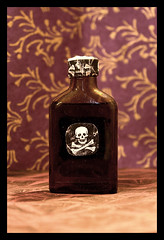Ch 1. Introduction to Forensic Science Flashcards
Terms : Hide Images [1]
| 14136744266 | Forensic Science | The application of science to criminal and civil laws. | 0 | |
| 14136744267 | Dr. Leone Lattes | Discovered a way to analyze dried blood into blood groupings | 1 | |
| 14136744268 | Alphonse Bertillon | Devised the first scientific system of personal identification called anthropometry. | 2 | |
| 14136744269 | Francis Galton | Conducted the first definitive study of fingerprints and their classification. | 3 | |
| 14136744270 | Sherlock Holmes | fictional character who first popularized scientific crime detection. |  | 4 |
| 14136744271 | Crime labs | Facilities specifically dedicated to forensic analysis of criminal evidence. |  | 5 |
| 14136744272 | major federal crime lab | FBI | 6 | |
| 14136744273 | Physical Science Unit | Principles and techniques of chemistry, physics, and geology use chemical tests and modern analytical instrumentation to examine drugs, glass, paint, explosives, and soil. | 7 | |
| 14136744274 | Biology Unit | analyzes DNA , DNA profiling,detection of dried blood stains, body fluids, hair and fiber comparison and botanical identification | 8 | |
| 14136744275 | Firearms Unit | Examines discharged bullets, cartridge cases, shotgun shells and ammunition. | 9 | |
| 14136744276 | Document Examination Unit | Studies handwriting and typewriting on questionable documents, also may analyze paper or ink. | 10 | |
| 14136744277 | Photography Unit | Examines and records physical evidence. Prepares photographic evidence for courtrooms. |  | 11 |
| 14136744278 | Toxicology Unit | Examines body fluids and organs to determine presence or absence or poisons and drugs. This is frequently done by the medical examiner's office. |  | 12 |
| 14136744279 | Latent Fingerprint Unit | Examines evidence for prints. |  | 13 |
| 14136744280 | Polygraph Unit | used by criminal investigators, not typically by forensic scientists , due to inadmissibility to the courts - it is supposed to detect lies |  | 14 |
| 14136744281 | Voiceprint Analysis Unit | Specialize in voice identification, look at a graphic representation of a voice. |  | 15 |
| 14136744282 | Crime-scene Investigation Unit | Specially trained personnel to collect and preserve physical evidence to be processed at the lab. |  | 16 |
| 14136744283 | the Chinese | Among the first recognize fingerprints as a means of identfication | 17 | |
| 14136744284 | CSI Effect | The simplification of forensic scientific procedures creating unrealistic expectations of the validity and clarity of forensic evidence | 18 | |
| 14136744285 | Forensic Computer and Digital Analysis | Identifying, collecting, preserving, and examining info from computers or cell phones. | 19 | |
| 14136744286 | Expert Witness | An individual whom the court determines to possess a particular skill of knowledge in a trade or profession that is not expected of the average layperson and that will aid a court in determining the truth. | 20 | |
| 14136744287 | Three basic functions of a forensic scientist | 1. Analyze physical evidence 2. Provide expert testimony 3. Furnishing training in the proper recognition, collection and preservation of physical evidence | 21 | |
| 14136744288 | Edmond Locard | Pioneered the first crime lab. | 22 | |
| 14136744289 | Physical Evidence | Any object that can establish that a crime has been committed or can link a crime and its victim or its perpetrator. | 23 | |
| 14136744290 | Locard's Exchange Principle. | When two objects come into contact with each other, a cross-transfer of materials will occur. | 24 | |
| 14136744291 | DNA Fingerprinting. DNA Profiling, DNA Typing | Revolutionized the practice of forensic science in the lab establishing the precise identity of a suspect. | 25 | |
| 14136744292 | Computerized Data Bases | .A significant development aiding in the identification of fingerprints, bullet markings, shell casings, and DNA by comparing thousands of pieces of evidence quickly. | 26 | |
| 14136744293 | Los Angeles Police Department 1923 | The oldest forensic crime lab in the United States. | 27 | |
| 14136744294 | FBI | Under the direction of J Edgar Hoover this crime lab was established and to be used Nationally. |  | 28 |
| 14136744295 | Crime Lab Development | Due to Criminal Rights, The increasing demand of case work, and the right of the criminal to immediate legal advice | 29 | |
| 14136744296 | Scientific Method | Collection of evidence that adheres to strict guidelines that ensure careful and systemic collection, organization, and analysis of information by this method |  | 30 |
| 14136744297 | FRYE STANDARD | Courts ruled that the procedure, technique, or principles must be generally accepted, by a meaningful segment of a scientific community. | 31 | |
| 14136744298 | Daubert Ruling | That trial judges have the responsibility for acting as the "Gatekeeper" for the admissibility of evidence in their court. | 32 | |
| 14136744299 | Inquiry | Analysis of physical evidence by constantly testing a hypothesis through experimentation. This questioning is | 33 | |
| 14136744300 | Anthropology | The taking of a series of body measurements to aid in distinguishing one person from another | 34 | |
| 14136744301 | Mathieu Orfila | investigated and published a treatise on the effects of toxins on animals by chemical analysis - also the father of forensics | 35 |
